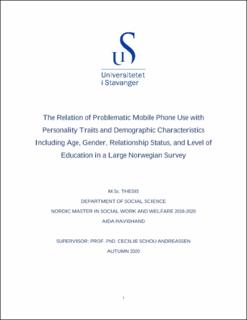| dc.description.abstract | Background: Research into problematic mobile phone use has considerably increased during recent years. Although the concept of problematic mobile use, also known as mobile phone addiction or mobile phone overuse, was first introduced in literature two decades ago, empirical research on the phenomenon is still limited. Important questions concerning the conceptualization, operationalization, antecedents, and outcomes of problematic mobile phone use remain to be answered scientifically.
Objective: The overall aim of this thesis was to investigate and broaden our understanding of the timely concept of problematic mobile phone use in terms of potential antecedents and correlates as measured by the Mobile Phone Addiction Index (MPAI). It is important to know personality traits in order to plan targeted prevention interventions in individuals with a tendency to show problematic behavior. Previous studies of the relationship between the Five-Factor Model (FFM) and problems were based on small samples not representative of the general population. Within the framework of contemporary theoretical models, the aim of this study was to examine the relationships between problematic mobile phone use and demographical and personality characteristics.
Methods: The MPAI was administrated online to a cross-sectional national sample of 23,533 adults (mean age = 35.8 years [SD = 13.3], range 16–88), together with an assessment of demographic variables (age, gender, relationship status, and education) and the five-factor model of personality (extroversion, agreeableness, conscientiousness, neuroticism, and openness to experience). Differences between groups were analyzed by regression models, adjusting got demographic variables.
Results: Demographic and personality factors were associated with problematic mobile phone use. In a multiple linear regression analysis, problematic mobile phone use was positively associated with lower age, being female and lower education. Extroversion, neuroticism, and agreeableness were positively associated with higher scores on the MPAI, whereas conscientiousness and openness to experience were inversely associated with MPAI scores. Demographic (13.7%) and personality (6.4%) variables explained 20.1% of the total variance in problematic mobile phone use. Age was the strongest predictor in the model, followed by neuroticism, conscientiousness, gender, and extroversion.
Conclusions: Higher levels of mobile phone problems appear to be associated with higher scores on neuroticism, extraversion, and agreeableness, and with lower scores on conscientiousness and intellect. The results obtained on addiction are consistent with the demographic estimates and associations contained in central theories. Thus, the cross-sectional study design makes reasoning about directionality impossible. Given this, the findings may assist the future practice in providing appropriate prevention and targeted intervention. | |
